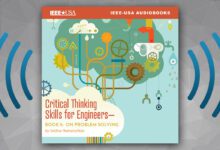
In his third IEEE-USA E-book, Career Transitioning – Book 3: As If Age Matters, Dr. Robert Danielle explores in depth the persistent problem of ageism in the workplace and the different forms it can take. Using examples from his own life, as well as stories from friends, co-workers and others, Danielle also discusses different ways to react to ageism, and help discourage it.
The author sets out to “explore ageism through multiple lenses, with the intent to raise situational and organizational awareness — as well as provide pathways to hope and prosperity — by sharing strategies to help combat the challenges facing older workers.”
Danielle makes the case that ageism often goes unnoticed; that most companies ignore it. However, he argues, ageism not only negatively impacts those victimized by it, but also adversely affects others who witness older co-workers’ experiences and knowledge being undervalued.
The author also indicates the problem is growing, citing surveys showing more than “75 percent of older employees say they’ve seen or experienced age discrimination in the workplace, the highest percentage in almost twenty years.”
Danielle goes through the various ways in which ageism can be manifested, from the tolerance of open ageism (leaders claiming “younger employees are the future,” or “this is what happens to all older employees when they don’t retire early”), to more subtle microaggressions. Microaggressions against older employees are intentional or unintentional acts that isolate an individual from a larger group. These actions might include excluding them from key meetings, discarding (or ignoring) their comments in discussions, not including them in professional development opportunities — or overlooking them for promotions.
He gives examples of other types of ageism, such as a recruiter using an older employer to fill out a slate, contrasting age with a younger applicant, or simply showing they can bring qualified candidates to the table — while not really considering the experienced worker for the position.
Older employees also discussed being used for free consultancy, when they are looking for a new position. One person was asked to critique the company website as part of a job interview process—and ended up seeing the changes they had outlined implemented shortly after they were turned down for the position.
Danielle suggests first recognizing key codewords that are used in hiring, promotions and performance evaluations that show a bias in favor of younger workers (or against older ones), and then developing a strategy to help work against this bias.
Some of the techniques he suggests are:
- Stress you are a lifelong learner
- Talk about your desire to be a long-term contributor
- Show confidence, energy and passion
- Take the time to research the needs of the organization; illustrate how your skills and expertise could be vital to the company’s success
- Prepare a strong, well-rehearsed brand statement
- Use examples that combat perceptions of older workers (for example, talk about a passion for physical activities to challenge perceptions that an older worker might be low-energy)
He also suggested reviewing your resume and LinkedIn profile to remove older education dates and irrelevant work experience — making sure you have edited out the telltale signs of older workers (i.e., using two spaces after a period; using dashes, instead of periods, for phone numbers).
The author also feels that networking is important late in your career, stressing that it should not be about collecting vast numbers of Facebook friends, or LinkedIn contacts, since quality is more important than quantity. He advises, “The more personal and deeper the connection, the more real and strategic the contact becomes for both of you.”
Danielle has an optimistic view of a less ageist workplace in the future, not just because of growing awareness — but due to changing demographics. He notes those older than 65 are the fastest-growing segment of the U.S. labor force; and that “new career opportunities for older workers will increase, especially for those who bring the needed skills.”
Career Transitioning 101—Book 3: As If Age Matters is Danielle’s third book in the Career Transactions 101 series. His new book, along with the others in the series (Book 1: First Steps and Book 2: When Opportunity Knocks), are available to all IEEE members free at IEEE-USA’s online shop; or for $2.99 for non-members.
Danielle is an expert in organizational behavior, leadership development, adult learning, and career transitioning. He has held strategic roles in media, technology, government/military, higher education and e-commerce sectors. His work has focused on learning and development, leading large change initiatives, leadership development, and improving individual/team performance. Danielle holds a Doctorate in Higher Education and Organization Change; and an MS degree in Information Systems Management. He has served as an IEEE Student Branch Chair, and on the ABET accreditation process team for his university. Danielle holds a significant learning role on an advanced technology team at a large ecommerce and technology company based in Seattle.







